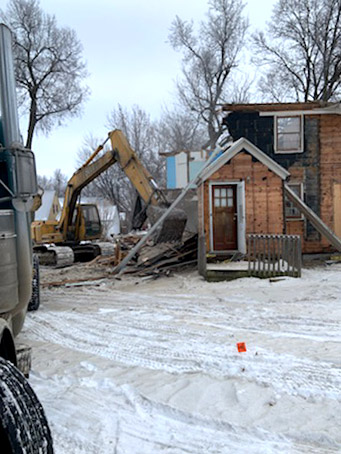
Several properties were demolished in recent weeks as part of Luverne’s continued effort to remove blight and encourage redevelopment.
The city purchased three properties this summer — two on Maple Street and one on South Highway 75 — and they were razed in the past couple of weeks.
Purchase prices of the three properties totaled $65,000 and demolition costs averaged $5,000 per structure.
They join more than 20 properties in town — 12 of them residential and eight commercial — that were similarly purchased over the past decade.
The program required an upfront investment of $350,000 in purchase and demolition costs over the past 10 years, but Call said increased property taxes on the improved lots more than pay for the costs.
“Yes, it does cost money to buy properties and demolish structures,” Call said.
“But when you balance that with increased tax base over the next 50 years, the rate of return is worth the investment.”
Commercial redevelopment results in $2 million of new tax base
History backs up this claim.
Call named 10 properties along the Highway 75 corridor through Luverne that were improved in recent years after the city bought blighted lots and prepared them for redevelopment.
For example, the city purchased the old turkey barns south of I-90 and demolished the blighted structures. The improved lot was later purchased by Crossroads Trailer Sales.
Similarly, the city purchased and demolished three blighted structures on the west side of Highway 75 where the new Ford dealership is now located.
Further north, the new Computer Clinic business is located on property that the city purchased from Ray Hoogeveen, removed the house and prepared the lot for development.
Crossroads, the Ford dealership and Computer Clinic are now generating $45,000 in new annual tax revenue.
This doesn’t count future revenue from the 27-unit mixed-use apartment complex planned for the Sharkee’s-Mert’s-China Inn property.
The city demolished those structures and prepared the combined lot to form a tax increment financing district. (Mert’s Welding moved to a new lot in Luverne’s industrial park.)
Other improved lots along Highway 75 include the historic but dilapidated yellow house north of W-2 Quality Meats and the recently demolished Vander Poel house near the Cozy Rest Hotel.
Residential redevelopment yields $3 million in new tax base
In terms of residential development, Call points to Barck Street projects as shining examples of blight turned to tax revenue.
On East Barck Street near the Blue Mound Avenue intersection, five blighted structures were purchased by the city and demolished to make way for new twin homes that are now generating tax revenue.
On West Barck Street toward the school, two older houses were demolished to make way for a four-plex that is currently under construction.
The Barck Street housing development alone will be worth over $30,000 in new tax revenue once the four-plex comes online next year.
The combined property taxes generated by the blighted lots previously amounted to roughly $3,000 per year.
“The new tax revenue is about 10 times more than it was before,” Call said.
Plus, he said, improved curb appeal in neighborhoods around town has a value all its own.
“The aesthetic value of safe and decent housing is something for the community to be proud of for generations to come,” Call said.


